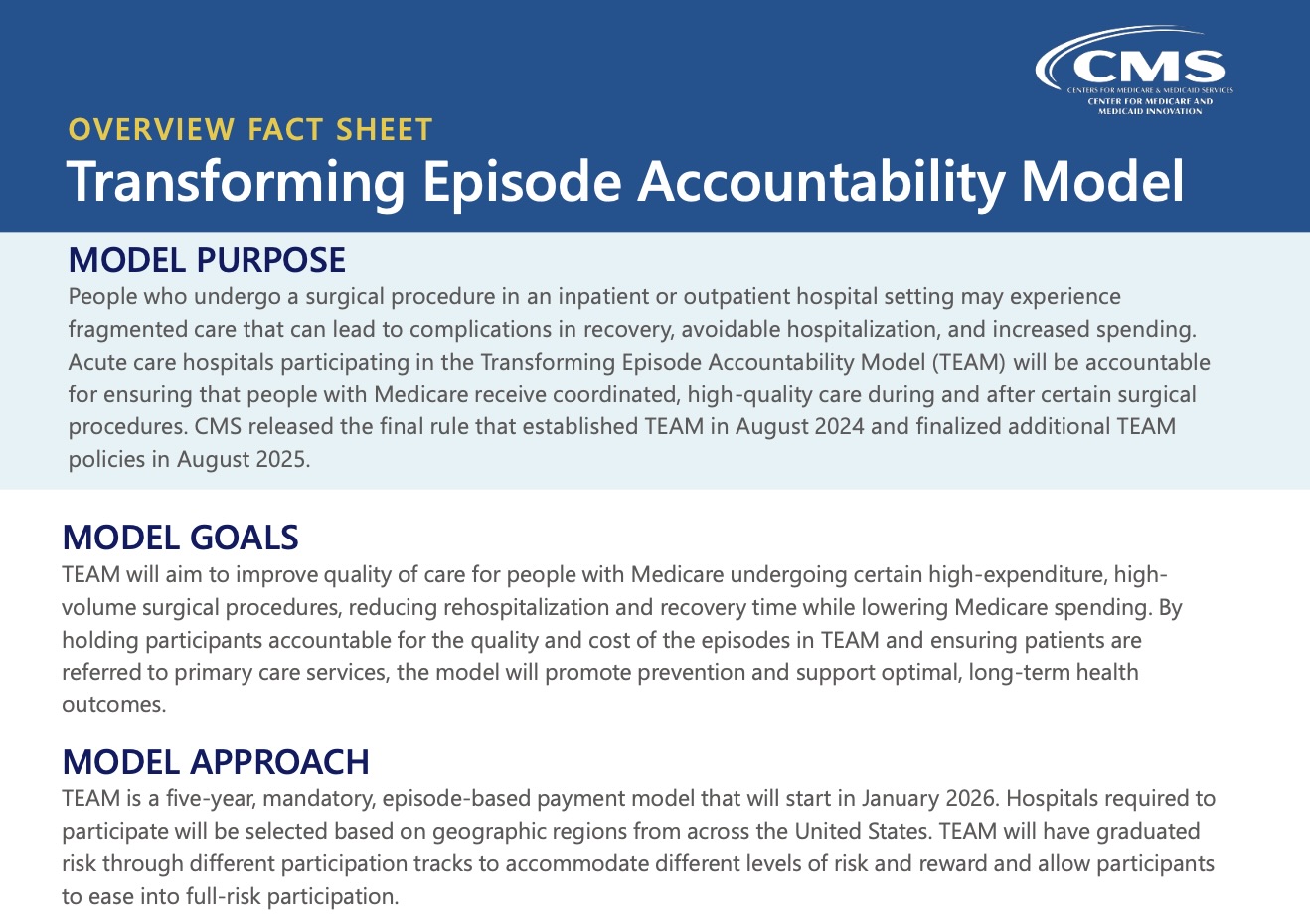
By Brian Murphy
Admission: I’m pro-TEAM. It’s possibly the name but I favor the concept of the new CMS payment model, too.
We keep spinning our wheels on the fee-for-service treadmill, which incentivizes volume and often results in unnecessary and fragmented care. Everyone complains about FFS, it’s hard to break free—but TEAM is a compelling attempt.
We need strong support systems and mutual cooperation if we’re to succeed in life. TEAM is here so let’s give it a shot.
To recap:
- TEAM=Transforming Episode Accountability Model. We’ll never remember; just say TEAM.
- TEAM is a five-year demonstration. It starts Jan. 1, 2026, and ends on Dec. 31, 2030.
- It’s mandatory. A subset of acute care hospitals are selected for inclusion, but those that are selected must participate.
- The model pertains to five broad “episode categories” that begin with one of the following procedures: coronary artery bypass graft (CABG), lower extremity joint replacement (LEJR), major bowel procedure, surgical hip and femur fracture treatment (SHFFT), and spinal fusion.
- You can get the actual MS-DRGs and HCPCS codes that initiate the episode in the FAQ below. CMS has assigned each of these a target price.
- Hospitals are responsible for overseeing a patient’s care from hospital admission or outpatient procedure through 30 days after the individual leaves the hospital, including coordination and communication between providers across all care settings and with the patient and family. This is where TEAM (and your care teams) kick in.
- TEAM participants and all Medicare providers and suppliers associated with an episode will continue to bill Medicare FFS, as usual. They will get paid as usual…
- … but, if participants perform well in the model, they may earn an additional payment. What does “performing well? mean? Spending below CMS’ target price for these episodes. If participants perform poorly (i.e., they spend above the target price), they will likely owe CMS a repayment amount.
- TEAM is risk adjusted, to include factors like patient age and social risk, as well as comorbidities. If you only perform concurrent CDI you’ll need to change your “old school” workflow to prospective. V28 of CMS-HCCs will be used as the risk adjustment model, based on dx codes reported 180 days before the IP admission. This is a recent change, as CMS initially proposed a 90-day window. As James Kennedy points out, this means you’ll need your CDI team to identify, get documented, and code the diagnoses before the IP stay begins.
- CMS in the recently released 2026 IPPS rule broadened the Skilled Nursing Facility (SNF) 3-Day Rule Waiver, allowing swing bed access without a 3-day inpatient stay.
- Questions? CMS has a dedicated email address: CMMI_TEAM@cms.hhs.gov
***
So, how would you describe your feelings about TEAM? Gung ho? Cautiously optimistic? Eye-roll, expecting another CMS bundled payment failure?
Send me at comment at brian.murphy@norwood.com.
References
- CMS, FAQ: https://www.cms.gov/team-frequently-asked-questions
- CMS, Fact sheet: https://www.cms.gov/files/document/team-model-fs.pdf
Related News & Insights
Don’t sleep on two important new changes hitting Jan. 1: Mandatory TEAM model and CMS-HCC V28 full payment shift
By Brian Murphy January 1 is rapidly closing in, and 2026 is bringing new rules and…
2026 OPPS final rule does no favors for our nation’s hospitals
By Brian Murphy The OPPS final rule, incredibly late this year, is finally out. Here I piece…


